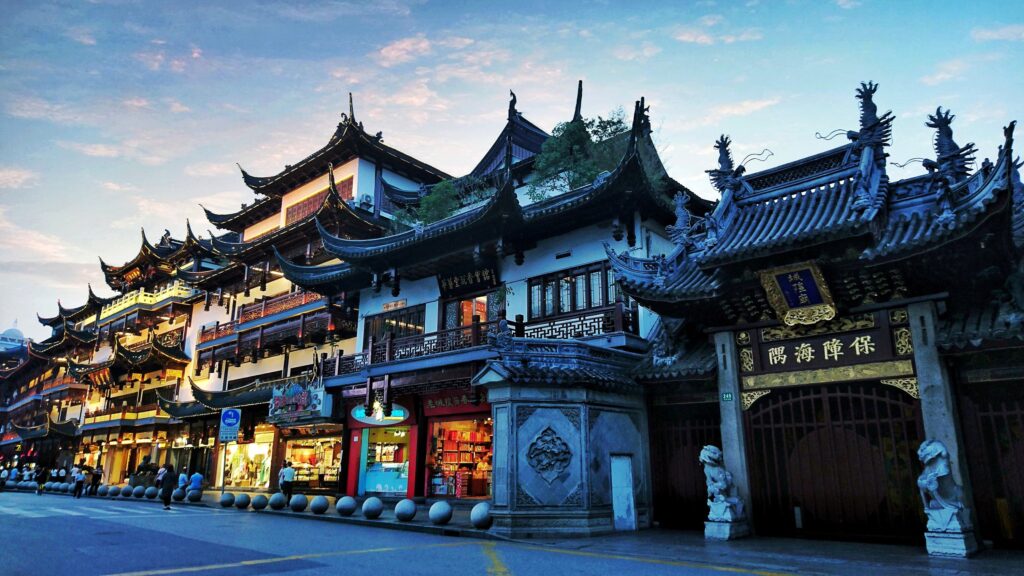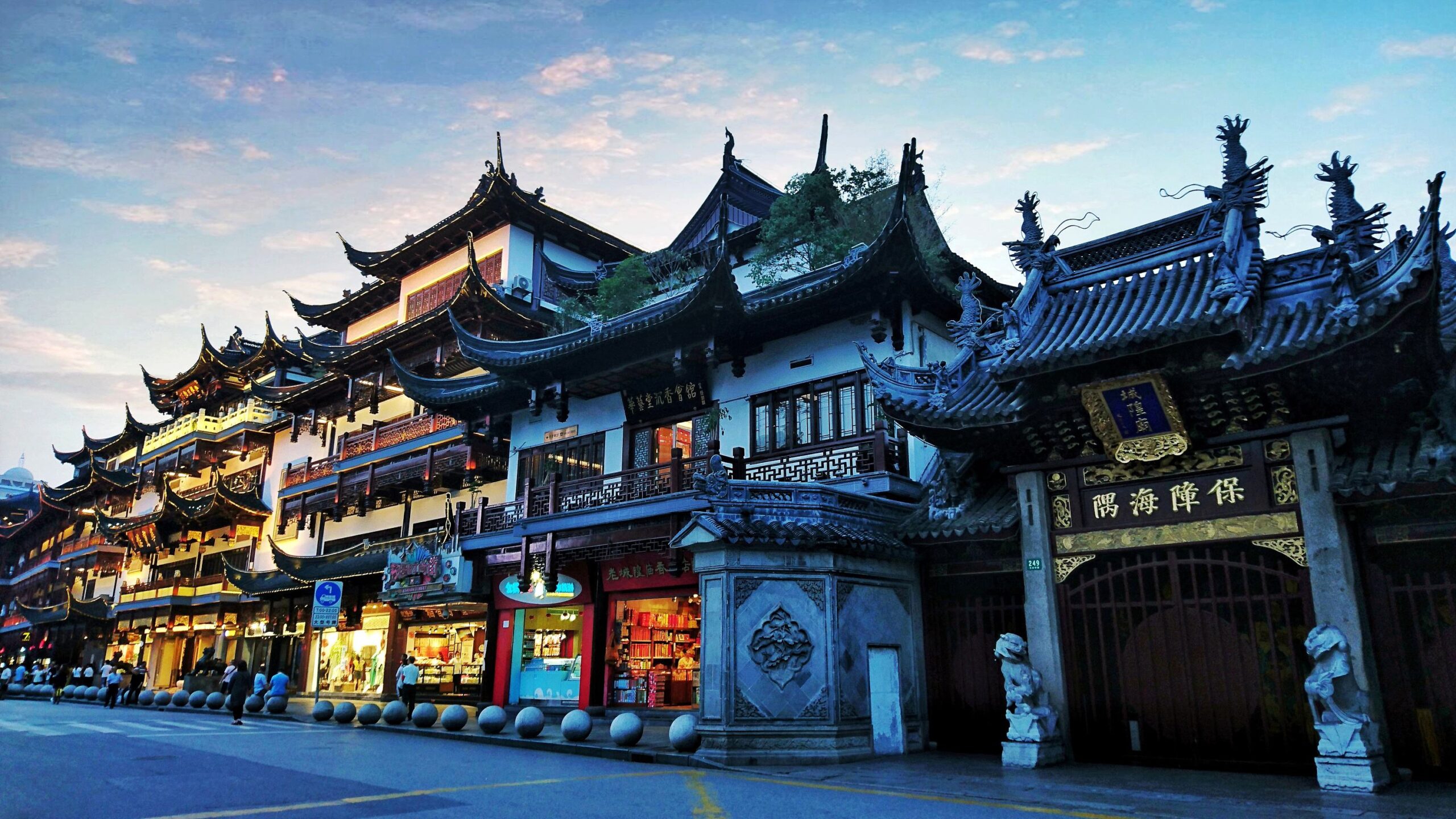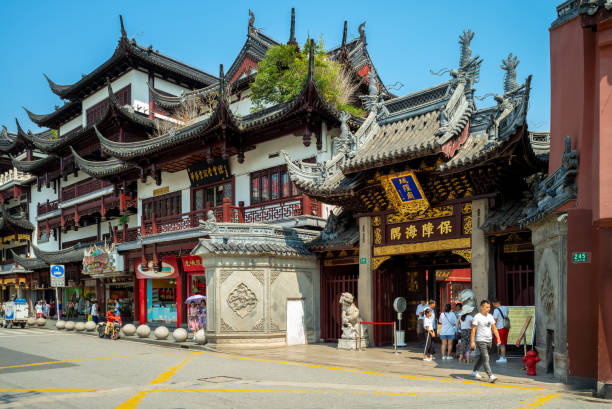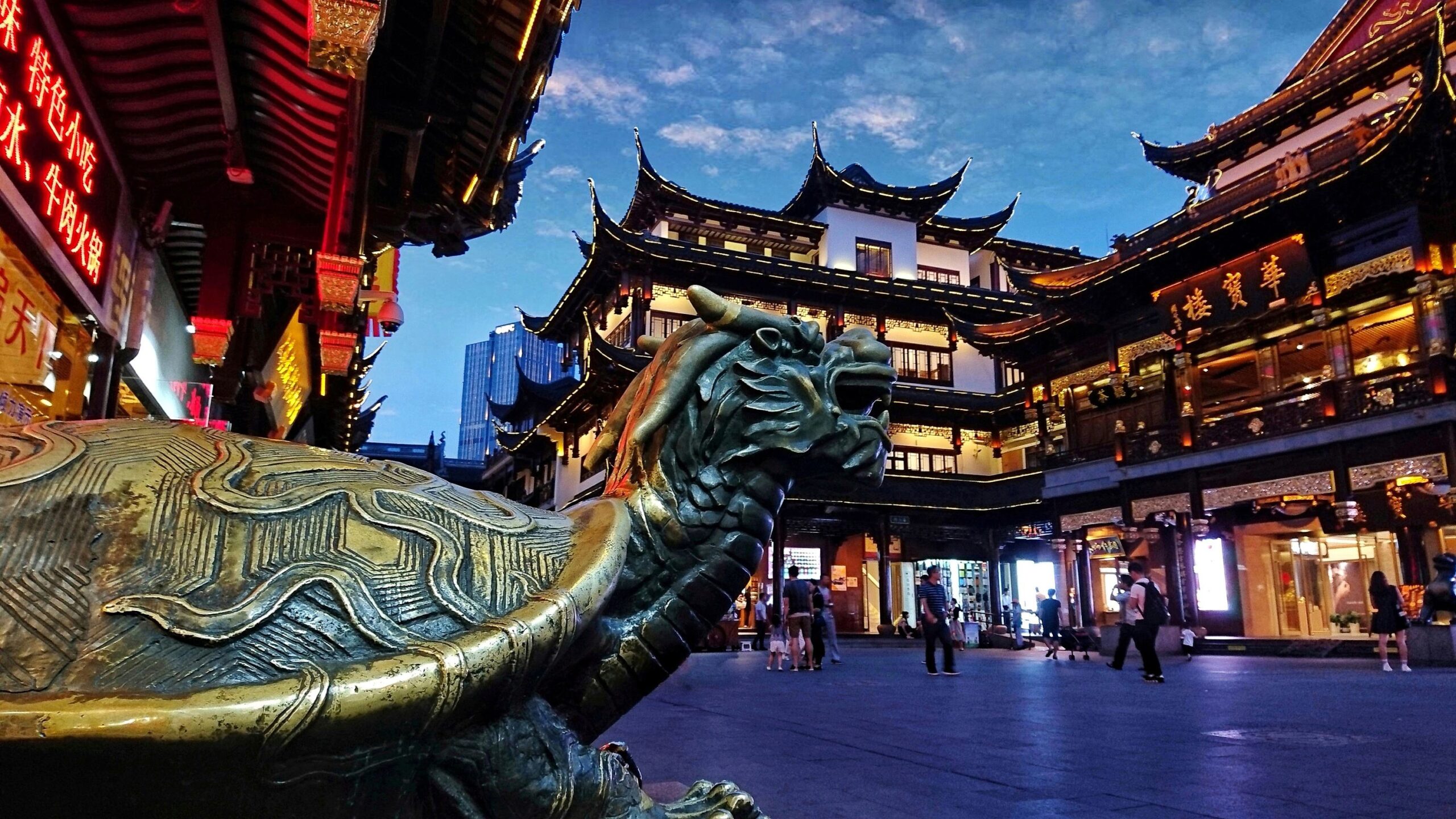Captivating Architecture and Rich Heritage: The City God Temple in the Heart of Shanghai

An Essential Guide to Visiting City_God_Temple_Of_Shanghai
Nestled amidst the bustling streets of Shanghai, the City God Temple (城隍庙) serves as a vibrant tapestry woven from the threads of faith, history, and culinary delights. As you step away from the towering glass skyscrapers that define the modern skyline, a different world unfolds—one dominated by the low hum of incense, the soft rustle of ancient wooden beams, and the palpable energy of devotion. Dating back to the Ming Dynasty, this temple is not merely a site of worship; it is a living embodiment of Shanghai’s cultural heritage, where locals and visitors alike gather to offer prayers, share meals, and immerse themselves in the rich traditions that pulse through the city’s veins.
Wander through the tranquil courtyards peppered with the sweet aroma of burning incense, and you’ll find yourself captivated by the intricate Taoist architecture and the rituals that play out in serene harmony. The juxtaposition of the temple’s spiritual essence against the chaotic, lively bazaar surrounding it creates a unique atmosphere that beckons travelers to stop, observe, and perhaps even participate in this time-honored dance of life. From the tantalizing scent of steaming Xiaolongbao to the vibrant chatter of vendors, the City God Temple is more than a destination—it’s an experience that encapsulates the essence of Shanghai, where the past and present intertwine seamlessly. Step inside, and let this sacred space guide you through the heart and soul of one of China’s most dynamic cities.
In This Guide
- An Essential Guide to Visiting City_God_Temple_Of_Shanghai
- The Rich History and Legends of City_God_Temple_Of_Shanghai
- Main Highlights: What You Absolutely Can’t Miss
- Planning Your Visit: A Practical Guide
- Tickets: Prices, Booking, and Tips
- How to Get There: A Complete Transportation Guide
- Local Cuisine and Accommodation Nearby
- Frequently Asked Questions
- Final Thoughts on Your Trip
The Rich History and Legends of City_God_Temple_Of_Shanghai
Nestled in the vibrant heart of Shanghai, the City God Temple (城隍庙) stands as a testament to the city’s rich tapestry of history, faith, and culture. Its origins trace back to the early 15th century during the Ming Dynasty, a time when Shanghai was merely a fledgling port town. The temple was initially a modest shrine dedicated to the City God, or Chenghuang, a deity revered for safeguarding the city and its waterways—a role that was of utmost significance as Shanghai began to burgeon into a major trade hub.
The temple’s establishment in 1403 coincided with the reign of the Yongle Emperor, who sought to fortify control over this strategic port. As merchants set out across the Huangpu River, they would stop to offer prayers for safe passage and prosperity at this emerging spiritual center. Over time, the City God Temple transformed from a small shrine into a bustling hub of religious and economic activity, where faith intertwined seamlessly with commerce. Local guilds flourished, and the temple became a focal point for rituals and celebrations, further embedding it into the community’s identity.
Throughout the Qing Dynasty and into the Republican era, the temple faced numerous challenges yet remained resilient. Its role expanded beyond that of a religious site; it became a vibrant social and cultural center. Festivals brought the temple to life, with performances and colorful decorations that attracted not just worshippers but also curious onlookers. The priests adapted to the changing times, often living modestly among the people they served, embodying a spirit of accessibility that endeared them to the community.
The City God Temple’s endurance through political unrest and urban transformation is remarkable. Despite the ravages of time—including damage from wars and the upheaval of the 20th century—the temple remained a cornerstone of Shanghai’s identity. Restoration efforts in the 1980s and 2000s revitalized its stunning architecture and intricate sculptures, allowing it to sparkle anew while retaining the echoes of its storied past.
In contemporary Shanghai, the City God Temple leads a dual existence. It is not only a revered site for local worshippers, who continue to flock here for blessings and guidance but also a popular destination for international travelers eager to witness a living piece of history. The temple’s atmosphere is imbued with the scents of burning incense and the sounds of prayers, creating a unique ambiance that transports visitors back through time.
Moreover, the surrounding bazaar, with its lively stalls and tantalizing street food, showcases the enduring spirit of commerce that has characterized the area for centuries. Now, as shoppers haggle over jade trinkets or savor steaming bowls of Xiaolongbao, they partake in an age-old tradition that has thrived alongside the sacred space of the temple.
The City God Temple of Shanghai is more than just an architectural marvel; it is a vibrant symbol of the city’s rich history and its ability to blend the sacred with the secular. For those wandering through its ancient halls, the temple offers a glimpse not only into the past but also into the heart of Shanghai’s enduring cultural heritage.

City_God_Temple_Of_Shanghai.
Main Highlights: What You Absolutely Can’t Miss
Visiting the City God Temple of Shanghai is an unforgettable experience that beautifully blends spirituality, culture, and culinary delights. Here are the main highlights that you absolutely cannot miss during your visit:
Iconic Architecture and Historic Halls
As you step into the City God Temple, the contrast between the traditional architecture and the modern skyline of Shanghai is striking. The temple’s glazed roofs curve upward like frozen waves, while the intricate wooden beams and pillars, adorned in vibrant reds, create a warm, inviting atmosphere. Each hall, though not expansive, resonates with history and devotion, showcasing Taoist deities and timeworn artifacts. Spend time wandering through the various halls and soaking in the ambiance; the soft tinkling of bells and the aroma of incense create a sensory experience unlike any other.
Engaging in Local Worship
What sets the City God Temple apart from typical tourist attractions is its genuine atmosphere of worship. Locals frequently visit, bowing, lighting incense, and whispering prayers for health, prosperity, and family safety. Even if you’re not a Taoist, participating by lighting incense can enhance your experience and connect you with the spiritual essence of the place. Look for bundles available for purchase at the entrance, typically costing between ¥10–20. This act of participation transforms your visit from mere observation to an authentic experience.
Culinary Delights Just Outside the Temple
No visit to the City God Temple is complete without indulging in the local delicacies that surround it. Just steps away, you’ll find vendors selling Xiaolongbao, delicate soup dumplings filled with flavorful broth, often costing between ¥25–40 for a basket. Don’t miss the chance to savor Zongzi, glutinous rice wrapped in bamboo leaves, filled with a variety of ingredients like red bean or salted egg, available for ¥10–15. The tempting smells wafting through the air are a prelude to a culinary adventure that is as integral to the experience as the temple itself.
The Bustling Bazaar Atmosphere
After exploring the temple, venture into the vibrant bazaar that envelops it. The shops, bustling with energy, offer everything from jade pendants to traditional tea sets. Engaging in a bit of bargaining can add to the fun; it’s not uncommon to see prices drop significantly with a little negotiation. Additionally, street performers add to the lively atmosphere, showcasing skills such as acrobatics or traditional music, making the bazaar a feast for both the eyes and ears.
The Magical Experience at Night
If time allows, return to the City God Temple at night when it transforms into a tranquil oasis amid the city’s hustle and bustle. The flickering lights and the soft glow of incense create an enchanting atmosphere, inviting you to reflect and immerse yourself in the serene environment. The juxtaposition of the lively bazaar and the calm of the temple makes for a unique evening experience.
Nearby Attractions
Finally, take advantage of the temple’s prime location by exploring nearby attractions. Just a short walk away is the Yu Garden, a stunning example of classical Chinese garden design. Spend time wandering through its tranquil paths, picturesque rockeries, and serene ponds, which offer a perfect complement to your visit to the City God Temple.
With its rich history, spiritual significance, delectable food, and vibrant atmosphere, the City God Temple of Shanghai is a must-visit destination that encapsulates the essence of the city. Make sure to set aside ample time to fully experience all that this remarkable site has to offer!

City_God_Temple_Of_Shanghai.
Planning Your Visit: A Practical Guide
Visiting the City God Temple of Shanghai is a journey that immerses you in the city’s rich tapestry of history, culture, and spirituality. Here’s a practical guide to help you make the most of your visit.
Getting There
By Metro
The easiest way to reach the City God Temple is by taking Metro Line 10 to Yuyuan Garden Station. Exit through Exit 3, and it’s just a 5–8 minute walk along Fuyou Road. As you approach, you’ll be greeted by the enticing aroma of street food and the hustle of local vendors.
By Taxi
If you prefer a taxi, expect a ride from the Bund to take about 15 minutes, costing around ¥25–35 depending on traffic. Since not all drivers may speak English, it’s advisable to show them the Chinese name: 城隍庙 (Chenghuangmiao).
Best Times to Visit
Visiting in the morning, around 9:00 AM, allows you to experience the temple in a serene atmosphere before the crowds arrive. If you’re interested in local worship practices, visiting during weekdays can offer a more authentic experience. Festivals like Chinese New Year can be vibrant but also crowded, so plan accordingly.
What to Expect
Upon entering, you’ll be struck by the stark contrast between the temple’s tranquil ambiance and the bustling modern city outside. The architecture features beautifully curved roofs and intricately painted wooden beams. Here are some highlights to explore:
-
Worship Halls: Take your time in the main worship hall, where locals often bow and offer incense. You can participate by lighting incense for a small fee of ¥10–20 at the entrance.
-
Atmosphere: Enjoy the sensory experience with the soft tinkling of bells, the fragrant incense, and the sight of worshippers engaged in their rituals. This isn’t just a tourist attraction; it’s a living part of Shanghai’s cultural identity.
-
Iconic Snacks: Don’t miss the culinary delights outside the temple. Try the famous Xiaolongbao (soup dumplings) at nearby stalls, usually costing ¥25–40 per basket. For a sweet treat, grab Zongzi (glutinous rice wrapped in bamboo leaves) for about ¥10–15.
Nearby Attractions
The City God Temple is conveniently located near several other attractions:
-
Yu Garden: Just a five-minute walk away, this classical Chinese garden opens at 8:30 AM. Admission is around ¥40, and it’s an excellent place to admire traditional architecture and serene landscapes.
-
Laocheng: Explore the traditional houses in this neighborhood for a glimpse of old Shanghai. It’s a great spot for photography and leisurely strolls.
Suggested Itinerary
For a half-day visit, consider this recommended itinerary:
-
9:00 AM: Arrive at the City God Temple. Spend about 40–45 minutes exploring the halls and observing local worshippers.
-
10:00 AM: Walk to Yu Garden and enjoy the peaceful morning atmosphere. Allocate 1–1.5 hours for your visit.
-
11:30 AM: Return to the bazaar near the temple for lunch. Enjoy the local snacks while soaking in the lively environment.
-
12:30 PM: Wrap up your visit, perhaps picking up a few souvenirs from the shops surrounding the temple.
Tips for Your Visit
-
Dress Appropriately: While there is no strict dress code, it’s respectful to dress modestly, especially when entering worship areas.
-
Be Mindful of Local Customs: If you choose to participate in offering incense, follow local practices respectfully. Observing is just as meaningful as participating.
-
Plan for Crowds: Weekends and public holidays can be particularly busy. If you prefer a quieter experience, aim for weekdays.
-
Stay Hydrated: With all the walking and exploring, make sure to keep hydrated, especially during warmer months.
Conclusion
Visiting the City God Temple of Shanghai offers a unique blend of spirituality, history, and local culture. By following this guide, you can navigate your visit with ease and fully immerse yourself in this remarkable facet of Shanghai’s heritage. Enjoy your journey!

City_God_Temple_Of_Shanghai.
Tickets: Prices, Booking, and Tips
When planning your visit to the City God Temple of Shanghai, it’s essential to be mindful of the ticket prices, booking options, and some handy tips to enhance your experience.
Ticket Prices
Entry to the City God Temple is free, allowing you to explore its sacred halls and tranquil courtyards without any cost. However, if you wish to participate in traditional practices such as lighting incense, you can purchase bundles at the entrance for approximately ¥10–20. This small fee provides a meaningful way to engage with the local customs and immerse yourself in the temple’s atmosphere.
Booking Information
There is no need for advance booking for the City God Temple, making it a flexible addition to your travel itinerary. Simply walk in during operating hours, which typically run from 7:00 AM to 5:30 PM. It’s advisable to arrive early in the morning or later in the afternoon to avoid the peak crowds, especially on weekends when the temple can become quite busy.
Tips for Your Visit
-
Timing is Key: To enjoy a quieter experience, consider visiting during weekdays or early mornings. The serene ambiance allows for a more contemplative visit.
-
Engage Respectfully: Feel free to light incense even if you are not a Taoist. This act is often seen as a gesture of respect, and locals appreciate participation from visitors.
-
Bring Cash: While the temple itself is free, nearby food stalls and souvenir shops may only accept cash. Have some yuan on hand for delicious snacks like Xiaolongbao and zongzi!
-
Explore the Surroundings: Don’t miss the bustling bazaar just outside the temple gates. It’s a fantastic place to shop for souvenirs, sample local delicacies, and soak in the vibrant atmosphere of old Shanghai.
-
Combine Visits: Pair your visit with a trip to the nearby Yu Garden, where you can enjoy beautiful landscapes and traditional architecture for a small entry fee of around ¥40. This combination makes for a fulfilling half-day itinerary.
By keeping these ticket details and tips in mind, your visit to the City God Temple of Shanghai will be both enriching and enjoyable, allowing you to truly connect with the heartbeat of this historic site.
How to Get There: A Complete Transportation Guide
Reaching the City God Temple of Shanghai is a breeze, thanks to the city’s efficient and user-friendly transportation system. Whether you prefer the metro, taxi, or rideshare services, getting to this iconic site is straightforward and convenient. Here’s how you can make your way to this remarkable destination.
By Metro
The metro is undoubtedly the most efficient means of transport to the City God Temple. Here’s how to do it:
- Take Line 10: Board the metro line 10 and head towards Yuyuan Garden Station (豫园站).
- Exit the Station: Once you arrive, use Exit 3. This will lead you directly to the bustling streets surrounding the temple.
- Walk to the Temple: From the exit, it’s just a short 5-8 minute walk along Fuyou Road. As you stroll, the air will be filled with the enticing aroma of street food, including the famous local dumplings.
A single metro ticket typically costs between ¥3 to ¥5, depending on your starting point. You can conveniently pay using Alipay, WeChat, or a contactless metro card.
By Taxi or Rideshare
If you prefer a more direct approach or are traveling in a group, taking a taxi or using a rideshare app like Didi can be a great choice:
- Taxi: Hail a taxi and provide the driver with the Chinese name for the temple, 城隍庙 (Chenghuangmiao), to avoid any communication barriers.
- Didi App: If you opt for Didi, simply enter your destination in the app.
The ride from popular areas like the Bund typically takes around 15 minutes and will cost you approximately ¥25 to ¥35, depending on traffic conditions. Do keep in mind that traffic can get heavy, especially on weekends, making the metro a faster option during peak times.
Nearby Attractions
Once you’re at the City God Temple, you’ll find yourself in the heart of one of Shanghai’s most vibrant districts. Just a stone’s throw away is Yu Garden, where you can explore beautiful traditional gardens and pavilions. The entrance fee is about ¥40.
Additionally, after your temple visit, take some time to wander through the bustling bazaars nearby. You’ll find a plethora of shops and stalls selling everything from jade pendants to delicious snacks—a perfect way to immerse yourself in the local culture.
Tips for a Smooth Journey
- Travel During Off-Peak Hours: If possible, try to visit during weekdays or early in the morning to avoid the weekend crowds.
- Language Barrier: If you’re not comfortable with Chinese, have the name of your destination written down to show to taxi drivers.
- Cash and Cards: While many places accept mobile payments, it’s wise to carry some cash for smaller vendors.
With these transportation options in mind, your journey to the City God Temple will be simple and enjoyable, allowing you to focus on exploring the rich history and vibrant culture that this remarkable site embodies.

City_God_Temple_Of_Shanghai.
Local Cuisine and Accommodation Nearby
As you explore the enchanting City God Temple of Shanghai, you’ll find that the culinary delights and accommodations in the surrounding area are just as captivating. The vibrant atmosphere of the bazaar and the delicious local dishes make for an unforgettable experience.
Delicious Local Cuisine
Just a stone’s throw from the temple, the bustling food scene awaits. Here are some must-try dishes:
-
Xiaolongbao (Soup Dumplings): Head to the renowned Nanxiang Xiaolongbao shop, where the tantalizing aroma of freshly steamed dumplings fills the air. Expect a queue, but locals swear that the wait is worth it for the delicate dumplings filled with savory broth, priced around ¥25–40 per basket. Be sure to sip the soup before devouring the dumpling to avoid a scalded tongue!
-
Zongzi (Sticky Rice Dumplings): For a quick snack, look for zongzi stalls nearby. These delightful parcels of glutinous rice wrapped in bamboo leaves come with various fillings, from sweet red bean paste to savory meats, typically costing around ¥10–15. Enjoying one while taking in the temple’s ambiance is an experience you won’t forget.
-
Street Snacks: Don’t miss the numerous food vendors lining the streets. Try scallion pancakes, stir-fried noodles, and fried pastries to get a taste of local flavors. Each bite is a burst of culinary culture, and the vibrant stalls make for perfect photo opportunities.
Cozy Accommodations
After indulging in the local cuisine, consider staying nearby for easy access to the temple and surrounding attractions. Here are a few recommended accommodations:
-
The Yangtze Boutique Shanghai: A stunning blend of Art Deco and traditional Chinese design, this luxury hotel is just a short drive from the City God Temple. With elegant rooms and top-notch amenities, it offers a serene retreat from the city’s hustle and bustle.
-
Motel 168 Shanghai Laoximen: For budget travelers, this chain hotel provides clean and comfortable rooms at an affordable price. Its convenient location allows easy access to both the temple and the vibrant markets, making it an ideal base for exploring.
-
Hanting Express Shanghai Yu Garden: Located near Yu Garden, this hotel is a fantastic option for those looking for modern comforts without breaking the bank. Enjoy a cozy stay and wake up to the sounds of the city as you plan your day’s adventures.
Final Thoughts
Whether you’re savoring mouthwatering dumplings or unwinding in a comfortable hotel, the area surrounding the City God Temple of Shanghai offers a unique blend of culture, flavor, and hospitality. Embrace the rhythm of the city, and let your culinary and accommodation experiences enhance your visit to this historic gem.

City_God_Temple_Of_Shanghai.
Frequently Asked Questions
-
What are the opening hours for the City God Temple of Shanghai?
The City God Temple is typically open from 8:30 AM to 5:30 PM. However, it’s advisable to check for any changes in hours, especially during public holidays or special events. -
How much does it cost to enter the temple?
Entrance to the City God Temple is generally free, but you may want to consider contributing a small donation if you participate in activities such as lighting incense. -
What is the best time to visit the City God Temple?
Early mornings, around 9:00 AM, are ideal for a quieter experience. Visiting during weekdays is also recommended to avoid large crowds. Festivals like Chinese New Year can offer a unique atmosphere but may be more crowded. -
How can I get to the City God Temple using public transport?
Take Metro Line 10 to Yuyuan Garden Station and exit through Exit 3. The temple is only a 5–8 minute walk from the station. A single metro ticket costs between ¥3 and ¥5, depending on your starting point. -
Are there any food options nearby?
Yes! The area surrounding the City God Temple is famous for its street food. Don’t miss trying the Xiaolongbao (soup dumplings) and zongzi (sticky rice wrapped in bamboo leaves) from local vendors. Prices typically range from ¥10 to ¥40 depending on what you order. -
Can I take photos inside the temple?
Photography is generally allowed in the temple, but be respectful of worshippers and avoid using flash. Some areas might have restrictions, so it’s always good to check for any signs indicating photography guidelines. -
What should I wear when visiting the temple?
Dress conservatively and comfortably. While there are no strict dress codes, it’s respectful to avoid overly casual attire. Comfortable shoes are also recommended since you’ll likely be walking around the temple and its surrounding areas. -
Are there any nearby attractions to visit after the temple?
Yes, the famous Yu Garden is just a short walk away and is worth a visit. You can also explore the bustling bazaar nearby, which offers various shops and street performances. This area is rich in cultural experiences and provides a fantastic end to your visit.
Final Thoughts on Your Trip
As your journey through the City God Temple of Shanghai draws to a close, take a moment to reflect on the unique tapestry of experiences you’ve woven together. This sacred space is not merely a destination; it is a living testament to the resilience of tradition amidst the relentless march of modernity. The gentle waft of incense, the rhythmic sound of prayers, and the vibrant energy of the bazaar create an atmosphere that envelops you, inviting you to pause and immerse yourself in the local culture.
Whether you found solace in the tranquil halls, savored the mouthwatering Xiaolongbao, or engaged in the lively marketplace, each element of your visit offers a glimpse into the heart of Shanghai’s rich heritage. The City God Temple serves as a bridge—connecting the past with the present, spirituality with commerce, and locals with travelers.
So, as you step back into the bustling streets, carry with you the memories of this enchanting place. Allow its spirit to resonate within you, reminding you that every journey is not just about the sights you see, but the stories you collect. May your travels continue to inspire and transform you, and may you always find spaces like this where faith, food, and life intertwine in beautiful harmony. Safe travels!